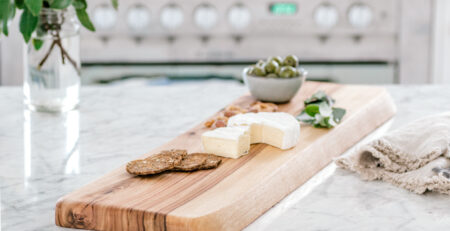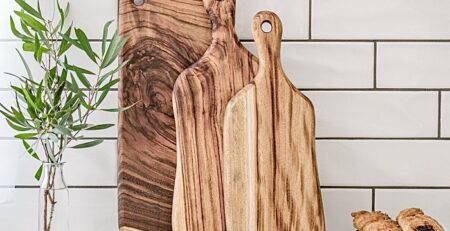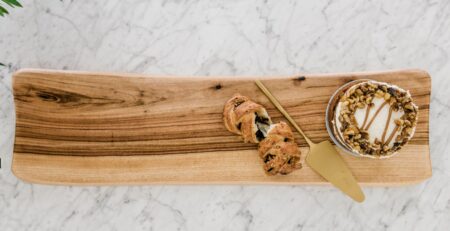What to look for in a cutting board an extensive guide
A cutting board and a knife are some of the few kitchenwares you use for practically every recipe. It’s hard to cook without sliced ingredients. Therefore you’ll need a cutting board.
But how much thought did you put into purchasing it?
When choosing a cutting board, there are a lot of aspects to consider for such a simple object. For example, although a chopping board appears relatively harmless, poor use can make it one of the most bacteria-laden pieces of kitchen equipment.
Here’s how to pick a cutting board that fits your budget and lifestyle and maintain clean and safe.
You have probably heard a lot of claims about how dangerous certain cutting boards can be. However, you can use any cutting board material following the necessary food handling and cleanliness procedures.
Here are some things to consider while choosing a board.
- Is it suitable for use with a knife? The tougher the surface, the faster your knife’s blade will dull.
- Is it simple to keep clean? Can you put it in the dishwasher if that’s essential to you?
- Is it simple to keep up with? Is it necessary to condition it with board oil regularly?
- How much does it cost?
- How long will it last? How often do you think you will have to replace it?
- What is the size of it? How much room do you have?
Wooden Cutting Board:
Edge grain and end grain wood cutting boards are available, each with benefits and drawbacks.
The Edge Grain Cutting Board:
Woodcut with the grain is used to make edge grain cutting boards. The board’s top surface is covered in long wood fibres. Because they are usually the cheapest, edge grain boards are the most prevalent form of wood cutting board.
Because the long wood board fibres don’t give much under the knife’s blade, edge grain boards are more prone to hold scarring from the knife’s blade. Edge grain boards are also harsher on knives than end grain boards.
The End Grain Cutting Board:
Fusing cross-section pieces of wood together creates end-grain wood cutting boards. The top of the board displays the wood’s rings rather than the wood’s side view (length). End grain boards are often a few inches thick, and because they’re more difficult to make, they’ll almost always be more expensive than edge grain boards.
End grain boards recover from use more quickly than edge grain boards, resulting in fewer grooves in the board. An end grain cutting board is more durable in this regard. Because the wood fibres have greater give, they are softer on blades.
Cutting Boards in Maple, Oak, camphor laurel chopping board and Cherry wood
Wooden cutting boards are safe, gentle on knives, and long-lasting when properly cared for. Wood cutting boards come in a wide variety of pricing.
The most durable cutting boards are maple, walnut, cherry, beech, camphor laurel cutting board and teak. These woods have fewer holes, making it more difficult for bacteria to access the board’s surface and for blades to create grooves where bacteria can hide. In addition, antimicrobial chemicals, such as tannins, are naturally found in wood.
Cutting Boards Made Of Bamboo
Bamboo cutting boards, are a grass that is more environmentally friendly than wood. A bamboo board is light but will endure long if properly cared for.
Bamboo cutting boards are available in end grain and edge grain forms. The cost of end grain is higher. Because bamboo is tougher than wood, it will dull your knife faster. It can be a wonderful cheap option if you prefer wood with the added benefit of sustainability.
Plastic Cutting Board:
Plastic cutting boards are a lighter, more colourful, and dishwasher-safe alternative to wooden cutting boards. Working with raw chicken, beef, fish, and other raw meats is easier with a plastic cutting board. In addition, bacteria from uncooked meat cannot be trapped on plastic cutting boards because they are not porous.
A plastic cutting board works nicely when you need to cut raw meat. In addition, plastic cutting boards can be used to cut any vegetables, fruits, bread, cheese, and other foods and raw meat.
Materials to Avoid When Making a Cutting Board:
The surfaces of marble, glass or granite are tough and can dull your knife. So these materials are not recommended.
Once you have selected the material for the cutting board, there are a few things to keep in mind.
The Size Of The Cutting Board:
Size matters when it comes to cutting boards. Smaller items can always be cut on a larger board, but larger items cannot be cut on a small cutting board.
If you go with a plastic cutting board, double-check that it will fit in your dishwasher. If you don’t have a dishwasher or prefer a wooden cutting board, ensure you have a convenient way to clean it after each use.
The Price And Affordability:
In terms of affordability, the plastic cutting board comes out on top. Hard maple or other hardwoods are used to make high-quality wooden cutting boards. If price is a big factor, a plastic cutting board will almost always be the most cost-effective option.
Keeping The Sanitary Aspect In Mind:
There has been much discussion about whether wood or synthetic cutting boards are more sanitary. Wooden boards provide natural protection since bacteria dislike the wooden surface and die if bacteria remain after cleaning. On the other hand, plastic boards have a non-porous surface that prevents juices from penetrating.
Plastic boards can also be sanitised in the dishwasher, where cleaning will likely eliminate all bacteria. However, wood cutting boards should not be soaked in water or put in the dishwasher. Cleaning a wooden cutting board properly involves washing it in hot soapy water right after use.
Replacing Cutting Board:
Some cutting boards need to be replaced more frequently than others. While replacing them once a year is a fair rule of thumb, some may survive longer. It also depends on how often you use your cutting boards and how well you maintain them.
You should usually replace your cutting board if it has a lot of deep grooves from regular use. The more grooves it has, and the larger they are, the more surface area available for retaining moisture and providing bacteria with a place to grow.
Alternative Applications of chopping boards:
Cutting boards are not just for cutting; some are too lovely to hide away in the kitchen. Smaller, rustic cutting boards are ideal for serving cheese and charcuterie, while our larger grazing boards are ideal for serving larger loaves of bread and assorted snacks. With reversible boards, you can utilise the chop-friendly side in the comfort of your kitchen while serving on the more ornamented side. You can find cheese board for sale Australia on Stonewood Collections.
You can use chopping boards as interior decor. You can also make clocks and hanging boards. You can also use old boards for home decor.
Tips for Cleaning and Caring for a Cutting Board
Wash your boards gently with soap and hot water, then leave them to air dry naturally if they’re wooden. A rubber or wooden cutting board should never be washed in the dishwasher. Rubber boards will be scuffed and damaged by strong heat and caustic conditions, while wooden chopping boards will warp.
Every three to four months, or more frequently if desired, coat and polish your cutting board with a food-safe oil, we recommend grapeseed oil. It will aid in the prevention of warping and splitting, as well as the prevention of stains.
Smaller wooden cutting boards should be stored vertically on their edge to keep them dry and prevent warping and splitting. Also, ensure there are no remaining water or food residues on the surface of butcher-block style boards, which are larger, thicker hardwood cutting boards that you don’t move around.
Finally:
When purchasing a cutting board, choosing plastic, wood, or other materials such as marble may not be as crucial as safety, sanitation, and storability. However, ensure the cutting board is the right size for the job and that it can be sterilised and kept safe from contamination.
When you are a beginner in the kitchen, any cutting board appears to suffice. However, as you get more experience in the kitchen, you will see how much of a difference a decent cutting board can make when chopping and slicing world cuisines. So, If you are looking for a new cutting board set, look at our Stonewoods Collections!









Leave a Reply